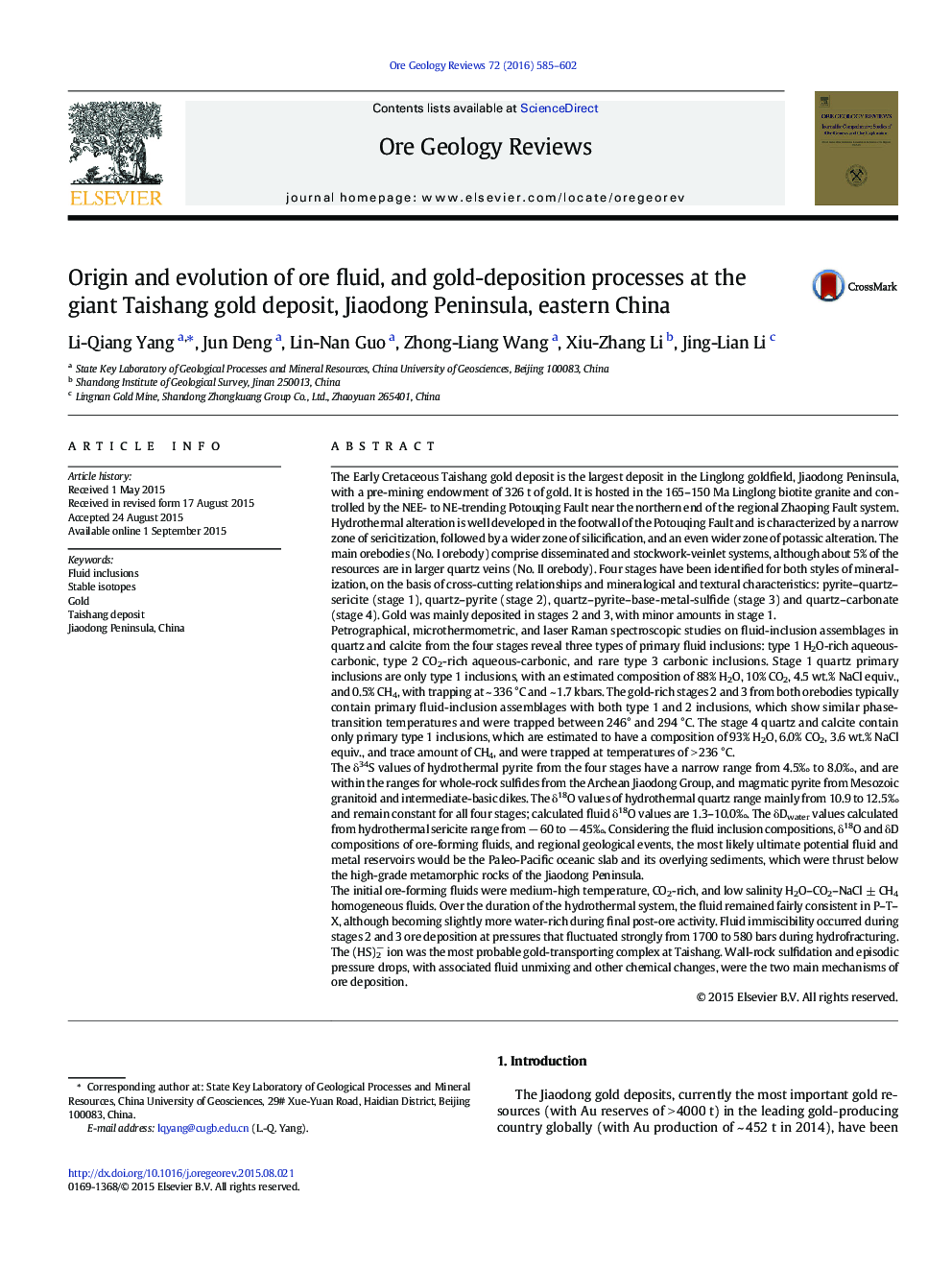| کد مقاله | کد نشریه | سال انتشار | مقاله انگلیسی | نسخه تمام متن |
|---|---|---|---|---|
| 6435775 | 1351852 | 2016 | 18 صفحه PDF | دانلود رایگان |
- Fluid immiscibility occurred at 1700-580 bars and 246-294 °C.
- Ore fluids were medium-high temperature, CO2-rich, and low salinity metamorphic fluids.
- Ore fluid and metal derived from paleo-Pacific oceanic slab and its overlying sediments
- Wallrock sulfidation and fluid unmixing were the two main mechanisms of ore deposition.
The Early Cretaceous Taishang gold deposit is the largest deposit in the Linglong goldfield, Jiaodong Peninsula, with a pre-mining endowment of 326 t of gold. It is hosted in the 165-150 Ma Linglong biotite granite and controlled by the NEE- to NE-trending Potouqing Fault near the northern end of the regional Zhaoping Fault system. Hydrothermal alteration is well developed in the footwall of the Potouqing Fault and is characterized by a narrow zone of sericitization, followed by a wider zone of silicification, and an even wider zone of potassic alteration. The main orebodies (No. I orebody) comprise disseminated and stockwork-veinlet systems, although about 5% of the resources are in larger quartz veins (No. II orebody). Four stages have been identified for both styles of mineralization, on the basis of cross-cutting relationships and mineralogical and textural characteristics: pyrite-quartz-sericite (stage 1), quartz-pyrite (stage 2), quartz-pyrite-base-metal-sulfide (stage 3) and quartz-carbonate (stage 4). Gold was mainly deposited in stages 2 and 3, with minor amounts in stage 1.Petrographical, microthermometric, and laser Raman spectroscopic studies on fluid-inclusion assemblages in quartz and calcite from the four stages reveal three types of primary fluid inclusions: type 1 H2O-rich aqueous-carbonic, type 2 CO2-rich aqueous-carbonic, and rare type 3 carbonic inclusions. Stage 1 quartz primary inclusions are only type 1 inclusions, with an estimated composition of 88% H2O, 10% CO2, 4.5 wt.% NaCl equiv., and 0.5% CH4, with trapping at ~ 336 °C and ~ 1.7 kbars. The gold-rich stages 2 and 3 from both orebodies typically contain primary fluid-inclusion assemblages with both type 1 and 2 inclusions, which show similar phase-transition temperatures and were trapped between 246° and 294 °C. The stage 4 quartz and calcite contain only primary type 1 inclusions, which are estimated to have a composition of 93% H2O, 6.0% CO2, 3.6 wt.% NaCl equiv., and trace amount of CH4, and were trapped at temperatures of > 236 °C.The δ34S values of hydrothermal pyrite from the four stages have a narrow range from 4.5â° to 8.0â°, and are within the ranges for whole-rock sulfides from the Archean Jiaodong Group, and magmatic pyrite from Mesozoic granitoid and intermediate-basic dikes. The δ18O values of hydrothermal quartz range mainly from 10.9 to 12.5â° and remain constant for all four stages; calculated fluid δ18O values are 1.3-10.0â°. The δDwater values calculated from hydrothermal sericite range from â 60 to â 45â°. Considering the fluid inclusion compositions, δ18O and δD compositions of ore-forming fluids, and regional geological events, the most likely ultimate potential fluid and metal reservoirs would be the Paleo-Pacific oceanic slab and its overlying sediments, which were thrust below the high-grade metamorphic rocks of the Jiaodong Peninsula.The initial ore-forming fluids were medium-high temperature, CO2-rich, and low salinity H2O-CO2-NaCl ± CH4 homogeneous fluids. Over the duration of the hydrothermal system, the fluid remained fairly consistent in P-T-X, although becoming slightly more water-rich during final post-ore activity. Fluid immiscibility occurred during stages 2 and 3 ore deposition at pressures that fluctuated strongly from 1700 to 580 bars during hydrofracturing. The (HS)2â ion was the most probable gold-transporting complex at Taishang. Wall-rock sulfidation and episodic pressure drops, with associated fluid unmixing and other chemical changes, were the two main mechanisms of ore deposition.
Journal: Ore Geology Reviews - Volume 72, Part 1, January 2016, Pages 585-602
